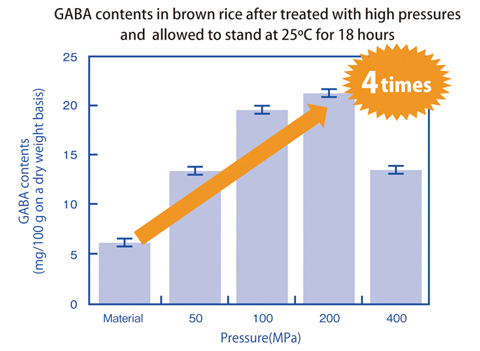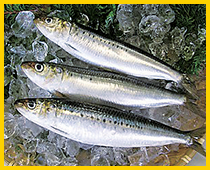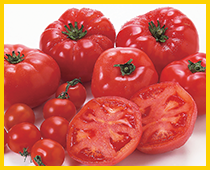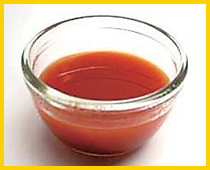What is "High-Pressure treatment"?
Practical cases where high-pressure treatment has been introduced
Enhancement of Functional Components in Agricultural Products after Harvest
Enhancement of Functional Components in Agricultural Products after Harvest
High-pressure treatment destroys tissues of agricultural products to accelerate reactions of endogenous enzymes with substrates originally present in cells, thereby enhancing a variety of functional components even after harvest.
Enhancement of GABA in brown rice
The substrate and the enzyme involved in a reaction are normally separated by the cell wall and cell membrane. Destruction of the cell wall and cell membrane initiates the biosynthesis. In brown rice, gamma-aminobutyric acid (GABA) is produced by the enzyme reaction between endogenous glutamic acid and glutamic acid decarboxylase (GAD).
What is GABA?
GABA is one of amino acids and considered to have a blood-pressure lowering effect , brain metabolism promoting effect and tranquilizing effect.

Increase in antioxidant capacity (ORAC) of tomato
It has been confirmed high-pressure treatment can improve the antioxidant effect of tomato. The reason for this is considered that biosynthesis of some components including lycopene, i.e., the typical functional component of tomato, polyphenols, vitamins and the like is accelerated by high-pressure treatment.

Acceleration of enzymatic degradation
When high pressure is applied to food for a long time, with the temperature being controlled for the enzyme reaction, the enzyme reaction is accelerated to ultimately degrade and liquefy the food, without decaying it.
For example, when a hermetically sealed vessel containing whole fish is long exposed to a high-pressure treatment, protein of the fish meat is decomposed into amino acid by the action of protease contained in the fish guts, thereby obtaining an extract with very intense umami.
Sardine
-

-

~100MPa、~24hours(50℃)
Tomato
-

-

~100MPa、~24hours(50℃)

